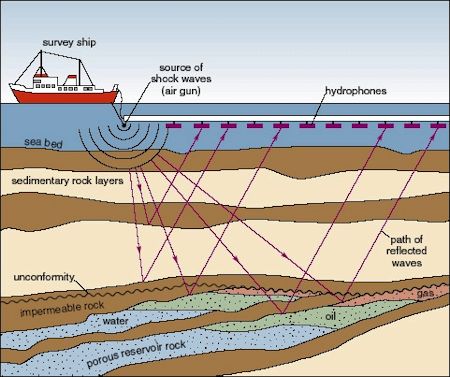KURE BEACH — A N.C. beach town mayor’s support of the petroleum industry’s push to explore for oil and natural gas resources off the Atlantic coast is stirring up local controversy as the federal government prepares to make a decision that could open the door to offshore drilling from Delaware to Florida.
Supporter Spotlight
The U.S. Department of Interior’s Bureau of Ocean Energy Management, or BOEM, is expected to release next month its final environmental impact statement on seismic surveying and the possible affects testing could have on marine life in the Atlantic.
 |
Last month, Kure Beach Mayor Dean Lambeth signed a letter endorsing seismic testing for oil and gas off the North Carolina coast. The letter was written by an industry lobbying group.
The industry for decades has used seismic surveying to pinpoint potential energy resources beneath the ocean floor. Such tests were last conducted in the Atlantic about 30 years ago and industry officials say, with today’s technology, they can get a more accurate picture of what lies beneath the seabed.
Supporter Spotlight
The center of the controversy over testing is the sound created during the surveys. Surveys use compressed air to create sounds waves, which travel from the ocean’s surface, to the seabed and back.
There are two methods of seismic surveying. Seismic airgun surveys produce acoustic pulses that are within the hearing range of all marine mammals. High resolution geophysical surveys typically use electromechanical sources like side-scan sonars, boomer and multi-beam depth sounders, some of which do not produce sound detectable to marine mammals.
These tests, environmentalists say, produce high-frequency sounds that harm marine mammals and interfere with the habits of fish populations crucial to the commercial fishing industry.
Groups including the Surfrider Foundation and Oceana, the world’s largest international ocean conservation organization, are petitioning the government against allowing the tests. Both organizations also oppose offshore drilling.
“We’re very concerned about the wildlife impacts,” said Ethan Crouch, chairman of the Surfrider Cape Fear Chapter. “Sound travels tremendously far in the water. To put it into perspective, the blasts from seismic airguns are 100,000 times more intense than a jet engine.”
Petroleum officials say there is no evidence that sound from seismic surveys harm marine mammals and that the industry uses precautions to mitigate impacts on marine life.
 Ethan Crouch |
David McGowan, executive director of the N.C. Petroleum Council, said the industry will follow all rules, regulations and laws to ensure testing is done safely. The council is the state chapter of the American Petroleum Institute, the only national trade association that represents all aspects of America’s oil and natural gas industry.
“I do come at it from a perspective of someone who grew up in Wilmington,” he said. “I love the coast. I’m an avid outdoorsman. First and foremost on my mind is the protection of our environment and natural resources and the tourism that drives the economy in our area. I don’t think by any stretch of the imagination the industry is saying those things are not important. Our message is it’s important to understand what kind of resources we have off our coast, what type of resources, how much and the challenges of trying to explore those resources. We think it makes sense to go out and do our due diligence. Seismic surveying is the first step in that process.”
Acoustic Effects
BOEM’s draft EIS examined the potential affects airgun and non-airgun surveying might have on marine mammals and fish in the Atlantic.
Both methods of surveying could “affect individuals from all marine mammal species within” the affected area, the document notes.
That’s an estimated 138,500 dolphins and whales, including the endangered North Atlantic right whale, blue whale, fin whale, sei whale, sperm whale and humpback whale, according to the study. The West Indian manatee and three pinniped species, which include seals, sea lions and walruses, are excluded from the list of impacted mammals because of they do not inhabit the areas in which testing would be conducted.
The draft study states that most of the effects to marine mammals “are expected to be avoided by mitigation.”
“Although these impacts are expected to be avoided to the maximum extent practicable, the mitigation measures included in the proposed action would not be 100 percent effective,” according to the study.
Incidents where behavioral patterns, including migration, breathing, nursing, breeding, feeding or sheltering, may be interrupted by non-airgun surveys, “are estimated to range from 0 to 476 individuals,” a year.
Surveying is even audible to humans in some cases, said BOEM spokeswoman Connie Gillette.
“The EIS does analyze effects to recreational resources, including diving,” she wrote in an email. “Hearing impacts on divers were scoped out as an effect of the action given the characteristics of G&G (geological and geophysical) noise and human hearing ranges. This is based partly on the experience in the Gulf of Mexico where G&G activities and diving regularly occur.”
Money Talks
 Dean Lambeth |
According to a December 2013 report from the American Petroleum Institute, offshore oil and natural gas development in the Atlantic could generate upwards of 280,000 jobs and contribute up to $23.5 billion to the U.S. economy each year. Most of the benefits would be accrued in states along the East Coast.
North Carolina stands to reap billions from offshore drilling.
API estimates that the equivalent of four million barrels of oil and about 19.5 trillion cubic feet of natural gas may be available in the mid-Atlantic, a large percentage of which include North Carolina, McGowan said.
“The resources are significant,” he said. “We’re using 30-year-old data for those numbers.”
Resource estimates for the Atlantic outer continental shelf include 3.3 billion barrels of oil and 31.3 trillion cubic feet of natural gas.
Updated surveys could lead to an increase in those figures, industry officials say. In 1987 the Minerals Management Service estimated about 9.5 billion barrels of oil in the Gulf of Mexico. Recent seismic tests and exploratory drilling skyrocketed the figure in 2011 to an estimated 48.4 billion barrels of oil, according to the institute.
Money generated from seismic testing leases may help pay for beach re-nourishment projects, Lambeth said.
Controversy in Kure Beach
He attended a handful of seminars hosted by America’s Energy Forum, a lobbying group backed by the institute, last year. When the group sent him a letter asking for his support, he obliged. A majority of the Kure Beach Town Council approved of Lambeth’s decision in a vote during their Dec. 17 meeting.
As word of the town’s letter of support spread, Lambeth and the council began, “getting a lot of blowback from the environmental people,” he said. Lambeth said he has not reviewed the draft EIS.
 Oceana stages a protest outside the U.S. Department of Interior in Washington. Photo: Oceana |
“I don’t see where the seismic testing is going to hurt anything,” Lambeth said. “I still don’t understand all this hoopla from people who are against it. They’re talking about all these whales and dolphins getting killed. They have no proof that it hurts the fish.”
The board has scheduled a Jan. 27 meeting where two people – a representative of the oil and gas industry and an environmental spokesperson – will talk about seismic surveying.
“We’ll duke it out,” Lambeth said. “Both sides need to have all the facts and not he-said, she-said. My God, they better show me the environmental part of it. They better show me the facts.”
Surfrider is organizing a rally at the meeting, where the organization is encouraging as many people as possible to speak.
“One of our biggest concerns is that (Lambeth) signed this letter without taking any public comment on the issue,” Crouch said.
The town council’s Jan. 27 meeting is not a public hearing and the council will not make a decision following comments, Lambeth said.
“I’ve already made the decision,” he said.
The town meeting will be held roughly one month before BOEM is expected to release the final EIS in late February.
There will be a 30-day public comment period once the study is released. BOEM must wait a minimum of 30 days after the study’s release before a decision is rendered.
BOEM already has received applications from oil and gas companies to obtain permits to survey in the Atlantic, Gillette said.
“We can’t provide a timeline of when surveys may actually begin as each permit will undergo site-specific NEPA (National Environmental Policy Act) evaluations and all other applicable consultations,” Gillette wrote in an email.
Applicants must also receive authorization under the Marine Mammal Protection Act and from the National Marine Fisheries Service prior to surveying. Under the MMPA, surveyors must notify the public of the time and location prior to testing.
If the government allows surveying in the Atlantic, offshore drilling could begin as early as 2019 with he first oil and natural gas production starting in 2026, according to BOEM.








